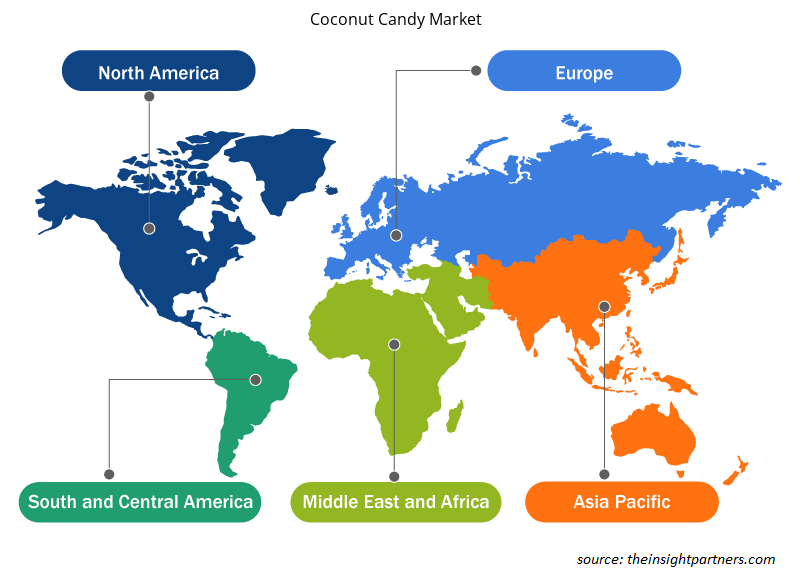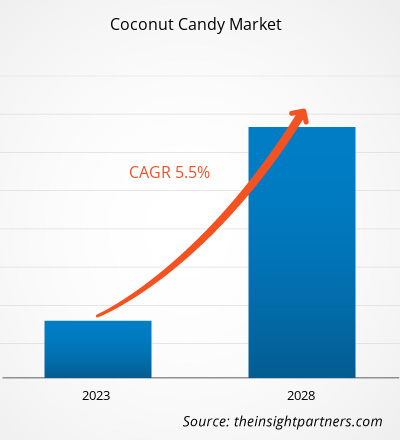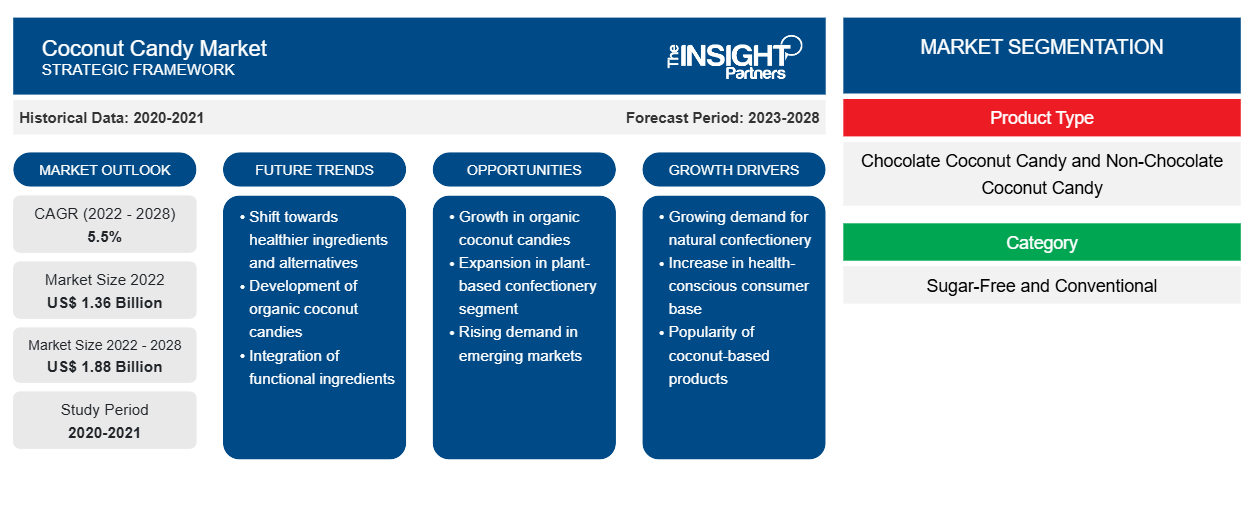Der Markt für Kokosnussbonbons soll voraussichtlich von 1.364,87 Millionen US-Dollar im Jahr 2022 wachsen und von 2022 bis 2028 eine durchschnittliche jährliche Wachstumsrate von 5,5 % aufweisen.
Kokosnüsse sind mit einer Reihe von gesundheitlichen Vorteilen verbunden. Sie sind reich an Vitaminen, Mineralien, Kohlenhydraten, mittelkettigen Triglyceriden und Ballaststoffen, die das Immunsystem stärken und die Gesundheit von Haut, Haaren und Knochen verbessern. Darüber hinaus haben Kokosnüsse einen einzigartigen exotischen Nussgeschmack, der Süßwaren und Pralinen eine reichhaltige Cremigkeit verleiht. Dunkle Schokolade ist eine der am häufigsten verwendeten Schokoladensorten, da sie seit langem für ihre stimmungsaufhellenden Eigenschaften bekannt ist. Darüber hinaus entsteht durch die Mischung von Kokosnuss und Schokolade ein einzigartiger Geschmack. Daher erfreuen sich schokoladenbasierte Kokosnussbonbons bei Verbrauchern aller Altersgruppen immer größerer Beliebtheit.
Der Markt für Kokosnussbonbons im asiatisch-pazifischen Raum ist in Australien, China, Indien, Japan, Südkorea und den Rest des asiatisch-pazifischen Raums segmentiert. Der globale Süßwarenmarkt , vor allem die Kokosnussbonbonindustrie, wird durch die Veränderung der Ernährungsgewohnheiten und Essgewohnheiten der Verbraucher angetrieben. Der Anstieg des verfügbaren Einkommens und der Kaufpräferenzen hat sich auch positiv auf den Markt für Kokosnussbonbons in den Entwicklungsländern im asiatisch-pazifischen Raum ausgewirkt. Außerdem trägt der asiatisch-pazifische Raum erheblich zur Produktion und zum Konsum von Kokosnussprodukten bei, da die größten Plantagen in Ländern wie Indonesien, den Philippinen, Indien, Sri Lanka und Vietnam zu finden sind. Laut einem Artikel der Ernährungs- und Landwirtschaftsorganisation der Vereinten Nationen entfallen auf die 15 Mitgliedsländer der Asiatisch-Pazifischen Kokosnussgemeinschaft (APCC) der größte Anteil der Plantagenfläche und der Kokosnussproduktion, zusammen 10,7 Millionen ha (87 %) und 9,2 Millionen Tonnen Kopraäquivalent (82,81 %). Indonesien, die Philippinen und Indien sind die größten Kokosnussproduzenten der Welt. Daher ist es für Hersteller einfach, den Rohstoff für die Herstellung von Süßwaren auf Kokosnussbasis, wie etwa Kokosnussbonbons, zu beschaffen.
Passen Sie diesen Bericht Ihren Anforderungen an
Sie erhalten kostenlose Anpassungen an jedem Bericht, einschließlich Teilen dieses Berichts oder einer Analyse auf Länderebene, eines Excel-Datenpakets sowie tolle Angebote und Rabatte für Start-ups und Universitäten.
- Holen Sie sich die wichtigsten Markttrends aus diesem Bericht.Dieses KOSTENLOSE Beispiel umfasst eine Datenanalyse von Markttrends bis hin zu Schätzungen und Prognosen.
Markteinblicke
Strategische Initiativen wichtiger Marktteilnehmer, um Marktteilnehmern in den kommenden Jahren Wachstumschancen zu bieten
Die Unternehmen auf dem Markt für Kokosnussbonbons verfolgen Strategien wie Produktinnovation und kreative Marketingkampagnen, um ihre Kundenreichweite zu erhöhen. Im Juni 2022 brachte Cocomels, eine in den USA ansässige Marke von JJ Sweets, ein zuckerarmes Karamellbonbon auf den Markt, das mit Kokosmilch hergestellt wird . Das Produkt enthält Kokoscreme als Hauptzutat, was ihm einen reichen, nussigen Geschmack und ein tolles Mundgefühl verleiht. Es ist mit kalorienarmen Süßstoffen wie Allulose und Mönchsfrucht gesüßt und frei von Milchprodukten, Gluten, Cholesterin und Maissirup. Mit solchen Produkteinführungen zielt Cocomels darauf ab, kalorienbewusste Verbraucher anzusprechen, die beim Geschmack keine Kompromisse eingehen möchten.Cocomels, a US-based brand of JJ Sweets, launched a low-sugar caramel candy made with allulose and monk fruit, and is free of dairy, gluten, cholesterol, and corn syrup. With such product launches, Cocomels aims to target calorie-conscious consumers that are not willing to compromise on taste.
Darüber hinaus bringen Unternehmen individuelle Geschenkboxen mit einer Mischung verschiedener Süßigkeiten für Feste und besondere Anlässe auf den Markt. Im April 2022 brachte Ferrero eine speziell für Ostern zusammengestellte Produktreihe auf den Markt, die Leckereien und Geschenkboxen umfasste. Die Ferrero Collection Bunny Gift Box beispielsweise umfasste 13 Stücke hochwertiger Süßwaren, darunter Raffaello mit Kokosnuss und Mandeln, Ferrero Rocher Haselnusspralinen und Rondnoir dunkle Schokolade mit knusprigen Waffeln. Solche innovativen Produktangebote dürften den Verkauf von Kokosnussbonbons im Prognosezeitraum ankurbeln.Ferrero launched a range of products specially curated for Easter, which included treats and gift boxes. For example, the Ferrero Collection Bunny Gift Box comprised 13 pieces of premium confections including Raffaello, containing coconut and almonds; Ferrero Rocher hazelnut chocolates; and Rondnoir dark chocolates with crisp wafers. Such innovative product offerings are expected to drive the sales of coconut candies during the forecast period.
Einblicke in Produkttypen
Basierend auf dem Produkttyp ist der Markt für Kokosnussbonbons in Schokoladen-Kokosnussbonbons und nicht-Schokoladen-Kokosnussbonbons segmentiert. Im Jahr 2021 hatte das Segment der Schokoladen-Kokosnussbonbons den größten Marktanteil. Der Verzehr von Schokolade hilft, depressives Verhalten zu reduzieren, da Schokolade antioxidative und entzündungshemmende Eigenschaften hat. Bei der Herstellung von Kokosnussbonbons werden verschiedene Schokoladensorten als Füllung oder Überzug verwendet. Dunkle Schokolade ist eine der am häufigsten verwendeten Schokoladensorten, da sie seit langem für ihre stimmungsverändernden Eigenschaften bekannt ist. Darüber hinaus erzeugt die Mischung aus Kokosnuss und Schokolade einen einzigartigen Geschmack. Daher sind schokoladenbasierte Kokosnussbonbons bei Menschen jeden Alters sehr beliebt.
Ferrero International SA; The Hershey Company; Russell Stover Chocolates, LLC.; Mars Incorporated; Chocoladefabriken Lindt und Sprüngli AG; Unreal Brands Inc.; Alfred Ritter GmbH & Co. KG; Tru Fru LLC.; Godiva; und Weetabix Food Co. sind die wichtigsten Akteure auf dem Markt für Kokosnussbonbons. Die führenden Akteure verfolgen Strategien wie Fusionen und Übernahmen sowie Produkteinführungen, um ihre geografische Präsenz und ihren Kundenstamm zu erweitern.
Regionale Einblicke in den Markt für Kokosnussbonbons
Die regionalen Trends und Faktoren, die den Markt für Kokosnussbonbons im Prognosezeitraum beeinflussen, wurden von den Analysten von Insight Partners ausführlich erläutert. In diesem Abschnitt werden auch die Marktsegmente und die Geografie von Kokosnussbonbons in Nordamerika, Europa, im asiatisch-pazifischen Raum, im Nahen Osten und Afrika sowie in Süd- und Mittelamerika erörtert.

- Erhalten Sie regionale Daten zum Markt für Kokosnussbonbons
Umfang des Marktberichts über Kokosnussbonbons
| Berichtsattribut | Details |
|---|---|
| Marktgröße im Jahr 2022 | 1,36 Milliarden US-Dollar |
| Marktgröße bis 2028 | 1,88 Milliarden US-Dollar |
| Globale CAGR (2022 - 2028) | 5,5 % |
| Historische Daten | 2020-2021 |
| Prognosezeitraum | 2023–2028 |
| Abgedeckte Segmente | Nach Produkttyp
|
| Abgedeckte Regionen und Länder | Nordamerika
|
| Marktführer und wichtige Unternehmensprofile |
|
Marktteilnehmerdichte für Kokosnussbonbons: Auswirkungen auf die Geschäftsdynamik verstehen
Der Markt für Kokosnussbonbons wächst rasant, angetrieben von der steigenden Nachfrage der Endverbraucher aufgrund von Faktoren wie sich entwickelnden Verbraucherpräferenzen, technologischen Fortschritten und einem größeren Bewusstsein für die Vorteile des Produkts. Mit steigender Nachfrage erweitern Unternehmen ihr Angebot, entwickeln Innovationen, um die Bedürfnisse der Verbraucher zu erfüllen, und nutzen neue Trends, was das Marktwachstum weiter ankurbelt.
Die Marktteilnehmerdichte bezieht sich auf die Verteilung der Firmen oder Unternehmen, die in einem bestimmten Markt oder einer bestimmten Branche tätig sind. Sie gibt an, wie viele Wettbewerber (Marktteilnehmer) in einem bestimmten Marktraum im Verhältnis zu seiner Größe oder seinem gesamten Marktwert präsent sind.
Die wichtigsten auf dem Markt für Kokosnussbonbons tätigen Unternehmen sind:
- Ferrero International SA
- Die Hershey Company
- Russell Stover Schokoladen, LLC.
- Mars Incorporated
- Schokoladenfabriken Lindt und Spruengli AG
Haftungsausschluss : Die oben aufgeführten Unternehmen sind nicht in einer bestimmten Reihenfolge aufgeführt.

- Überblick über die wichtigsten Akteure auf dem Markt für Kokosnuss-Süßigkeiten
Bericht-Spotlights
- Progressive Trends in der Kokosnuss-Süßigkeitenindustrie helfen den Akteuren bei der Entwicklung wirksamer langfristiger Strategien
- Von Unternehmen verfolgte Geschäftswachstumsstrategien zur Sicherung des Wachstums in entwickelten und sich entwickelnden Märkten
- Quantitative Analyse des Kokosnussbonbonmarktes von 2019 bis 2028
- Schätzung der Nachfrage nach Kokosnussbonbons
- Porters Fünf-Kräfte-Analyse zur Veranschaulichung der Wirksamkeit von Käufern und Lieferanten in der Branche
- Aktuelle Entwicklungen zum Verständnis des Wettbewerbsmarktszenarios
- Markttrends und -aussichten sowie Faktoren, die das Wachstum des Marktes für Kokosnussbonbons vorantreiben und bremsen
- Verstehen von Strategien, die das kommerzielle Interesse im Hinblick auf das Wachstum des Marktes für Kokosnussbonbons untermauern und den Entscheidungsprozess unterstützen
- Marktgröße für Kokosnussbonbons an verschiedenen Marktknoten
- Detaillierte Übersicht und Segmentierung des Kokosnussbonbonmarktes und seiner Branchendynamik
- Marktgröße von Kokosnussbonbons in verschiedenen Regionen mit vielversprechenden Wachstumschancen
Die „Globale Marktanalyse für Kokosnussbonbons bis 2028“ ist eine spezialisierte und eingehende Studie der Lebensmittel- und Getränkeindustrie, die sich auf die Trendanalyse des Marktes für Kokosnussbonbons konzentriert. Der Bericht soll einen Überblick über den Markt mit detaillierter Marktsegmentierung geben. Der Markt für Kokosnussbonbons ist nach Produkttyp, Kategorie und Vertriebskanal segmentiert. Basierend auf dem Produkttyp ist der Markt in Schokoladen-Kokosnussbonbons und nicht-Schokoladen-Kokosnussbonbons unterteilt. Basierend auf der Kategorie ist der Markt in zuckerfrei und konventionell unterteilt. Basierend auf dem Vertriebskanal ist der Markt für Kokosnussbonbons in Supermärkte und Hypermärkte, Convenience Stores, Online-Einzelhandel und andere segmentiert.
Firmenprofile
- Ferrero International SA
- Die Hershey Company
- Russell Stover Schokoladen, LLC.
- Mars Incorporated
- Schokoladenfabriken Lindt und Spruengli AG
- Unreal Brands Inc.
- Alfred Ritter GmbH & Co. KG
- Tru Fru LLC.
- Godiva
- Weetabix Food Co.
- Historische Analyse (2 Jahre), Basisjahr, Prognose (7 Jahre) mit CAGR
- PEST- und SWOT-Analyse
- Marktgröße Wert/Volumen – Global, Regional, Land
- Branchen- und Wettbewerbslandschaft
- Excel-Datensatz
Aktuelle Berichte
Verwandte Berichte
Erfahrungsberichte
Grund zum Kauf
- Fundierte Entscheidungsfindung
- Marktdynamik verstehen
- Wettbewerbsanalyse
- Kundeneinblicke
- Marktprognosen
- Risikominimierung
- Strategische Planung
- Investitionsbegründung
- Identifizierung neuer Märkte
- Verbesserung von Marketingstrategien
- Steigerung der Betriebseffizienz
- Anpassung an regulatorische Trends























 Kostenlose Probe anfordern für - Markt für Kokosnuss-Süßigkeiten
Kostenlose Probe anfordern für - Markt für Kokosnuss-Süßigkeiten